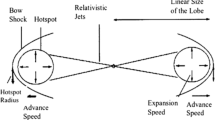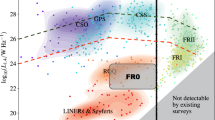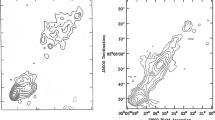Abstract
We carried out a comparative analysis on the properties the two arms (the longer arm and the shorter arm) on a sample of 98 FR-II radio galaxies comprising of 15 quasars, 11 broad-line radio galaxies, 57 narrow line radio galaxies and 15 low excitation radio galaxies within \(z\le1\). Our result indicates that in general, the arm lengths (lobe linear sizes) and luminosity, jets (lengths and luminosities), hotspots (sizes and luminosities), of the longer arm are larger than those of the shorter arm, while the lobe width and polarization of the shorter arm are larger than those of the longer arm. The differences are more in quasars, broad-line radio galaxies than in the narrow-line radio galaxies and low excitation radio galaxies. Our result generally indicates that beaming plays a role in the structure of more powerful radio sources while environmental factors seems more important in the structure and dynamics of the less powerful radio sources.

Similar content being viewed by others
References
Antonucci, R.R.J.: Annu. Rev. Astron. Astrophys. 31, 473 (1993)
Banhatti, D.G.: Astron. Astrophys. 84, 112 (1980)
Barthel, P.D.: In: Zensus, J., Pearson, T. (eds.) Superluminal Radio Sources, p. 148. Cambridge University Press, Cambridge (1987)
Barthel, P.D.: Astrophys. J. 336, 606 (1989)
Barthel, P.D.: In: Bicknell, G.V., Dopita, M.A., Quinn, P.J. (eds.) The Physics of Active Galaxies. ASP Conf. Ser., vol. 54., p. 175. Astron. Soc. Pac., San Francisco (1994)
Best, P.N., Bailer, M.D., Longair, M.S., Riley, J.M.: Mon. Not. R. Astron. Soc. 275, 1171 (1995)
Blandford, R.D., Kőnigl, A.: Astrophys. J. 232, 34 (1979)
Blandford, R.D., Rees, M.J.: Mon. Not. R. Astron. Soc. 169, 395 (1974)
Blundell, K.M., Rawlings, S., Willott, C.J.: Astron. J. 117, 677 (1999)
Chiaberge, M., Capetti, A., Celotti, A.: Astron. Astrophys. 394, 791 (2002)
Falle, S.A.E.G.: Mon. Not. R. Astron. Soc. 250, 581 (1991)
Fanaroff, B.L., Riley, J.M.: Mon. Not. R. Astron. Soc. 167, 31P (1974)
Garrington, S.T., Conway, R.G.: Mon. Not. R. Astron. Soc. 250, 198 (1991)
Garrington, S.T., Leahy, J.P., Conway, R.G., Laing, R.A.: Nature 331, 147 (1988)
Gopal-Krishna, Wiita, P.J.: Astrophys. J. 373, 325 (1991)
Gopal-Krishna, Wiita, P.J.: E-print (2004). arXiv:astro-ph/0409761
Hardcastle, M.J.: Astron. Astrophys. 414, 927 (2004)
Hardcastle, M.J.: Philos. Trans. R. Soc. A 363, 2711 (2005). doi:10.1098/rsta.2005.1667
Hardcastle, M.J., Alexander, P., Pooley, G.G., Riley, J.M.: Mon. Not. R. Astron. Soc. 296, 445 (1998)
Hardcastle, M.J., Harris, D.E., Worrall, D.M., Birkinshaw, M.: Astrophys. J. 612, 729 (2004)
Hardcastle, M.J., Evans, D.A., Croston, J.H.: Mon. Not. R. Astron. Soc. 370, 1893 (2006)
Heavens, A.F., Meisenheimer, K.: Mon. Not. R. Astron. Soc. 225, 335 (1987)
Hine, R.G., Longair, M.S.: Mon. Not. R. Astron. Soc. 188, 111 (1979)
Hintzen, P., Scott, J.S.: Astrophys. J. 224, L47 (1978)
Ingham, W., Morrison, P.: Mon. Not. R. Astron. Soc. 173, 569 (1975)
Jeyakumar, S., Wiita, P.J., Saikia, D.J., Hooda, J.S.: Astron. Astrophys. 432, 823J (2005)
Kaiser, C.R.: Astrophys. J. 362, 447 (2000)
Kaiser, C.R., Alexander, P.: Mon. Not. R. Astron. Soc. 286, 215 (1997)
Kaiser, C.R., Dennett-Thorpe, J., Alexander, P.: Mon. Not. R. Astron. Soc. 292, 723 (1997)
Komissarov, S.S., Falle, S.A.E.G.: Mon. Not. R. Astron. Soc. 288, 833 (1997)
Laing, R.A.: Nature 331, 149 (1988)
Laing, R.A., Riley, J.M., Longair, M.S.: Mon. Not. R. Astron. Soc. 204, 151 (1983)
Laing, R.A., Jenkins, C.R., Wall, J.V., Unger, S.W.: In: Bicknell, G.V., Dopita, M.A., Quinn, P.J. (eds.) The Physics of Active Galaxies ASP Conf. Ser., vol. 54, p. 201. Astron. Soc. Pac., San Francisco (1994)
Machalski, J., Chyźy, K.T., Jamrozy, M.: Acta Astron. 54, 391 (2004)
Macklin, J.T.: Mon. Not. R. Astron. Soc. 199, 1119 (1982)
Meisenheimer, K., Roser, H.J., Hiltner, P.R., Yates, M.G., Longair, M.S., Chini, R., Perley, R.A.: Astron. Astrophys. 219, 63 (1989)
Mullin, L.M., Hardcastle, M.J., Riley, J.M.: Mon. Not. R. Astron. Soc. 372, 113 (2006)
Mullin, L.M., Riley, J.M., Hardcastle, M.J.: Mon. Not. R. Astron. Soc. 390, 595 (2008) (MU08)
Nilsson, K.: Astron. Astrophys. Suppl. Ser. 132, 31 (1998)
Onuchukwu, C.C., Ubachukwu, A.A.: Astrophys. Space Sci. 344, 211 (2013). doi:10.1007/s10509-012-1325-x
Onuchukwu, C.C., Ubachukwu, A.A.: Rev. Mex. Astron. Astrofís. 50, 93 (2014)
Onuchukwu, C.C., Ubachukwu, A.A.: Astrophys. Space Sci. 357, 145 (2015). doi:10.1007/s10509-015-2386-4
Priya, A., Saikia, D.J., Singh, M., Chandola, H.C.: Mon. Not. R. Astron. Soc. 426, 758 (2012)
Rees, M.J.: Nature 211, 468 (1966)
Rees, M.J.: Mon. Not. R. Astron. Soc. 135, 345 (1967)
Rees, M.J.: Nature 2229, 312 (1971)
Ryle, M., Longair, M.S.: Mon. Not. R. Astron. Soc. 136, 123 (1967)
Ryś, S.: Astron. Astrophys. 281, 15 (1994)
Ryś, S.: Astron. Astrophys. 355, 79 (2000)
Saikia, D.J., Jeyakumar, S.K., Wiita, P.J., Sanger, H.S., Spencer, R.E.: Mon. Not. R. Astron. Soc. 276, 1215 (1995)
Saikia, D.J., Jeyakumar, S.K., Mantovani, F., Salter, C.J., Spencer, R.E., Thomasson, P., Wiita, P.J.: Publ. Astron. Soc. Aust. 20, 50 (2003)
Scheuer, P.A.G.: Mon. Not. R. Astron. Soc. 166, 513 (1974)
Scheuer, P.A.G.: In: Zensus, J., Pearson, T. (eds.) Superluminal Radio Sources, p. 104. Cambridge University Press, Cambridge (1987)
Teerikorpi, P.: Astron. Astrophys. 375, 752 (2001)
Urry, C.M., Padovani, P.: Publ. Astron. Soc. Pac. 107, 803 (1995)
Valtonen, M.J.: Astrophys. J. 231, 312 (1979)
Zensus, J.A.: Annu. Rev. Astron. Astrophys. 35, 607 (1997)
Zensus, J.A., Pearson, T.J.: In: Zensus, J.A., Pearson, T.J. (eds.) Superluminal Radio Sources. Cambridge University Press, Cambridge (1987)
Ziȩba, S., Chyźy, K.T.: Astron. Astrophys. 241, 2 (1991)
Acknowledgements
We acknowledge the useful discussion with Dr. F.C. Odoh at University of Nigeria Nsukka, Enugu State, Nigeria.
Author information
Authors and Affiliations
Corresponding author
Rights and permissions
About this article
Cite this article
Onuchukwu, C.C., Ubachukwu, A.A. A study of the properties of twin radio arms of FR-II extragalactic radio sources within \(z\le1\) . Astrophys Space Sci 362, 12 (2017). https://doi.org/10.1007/s10509-016-2984-9
Received:
Accepted:
Published:
DOI: https://doi.org/10.1007/s10509-016-2984-9




